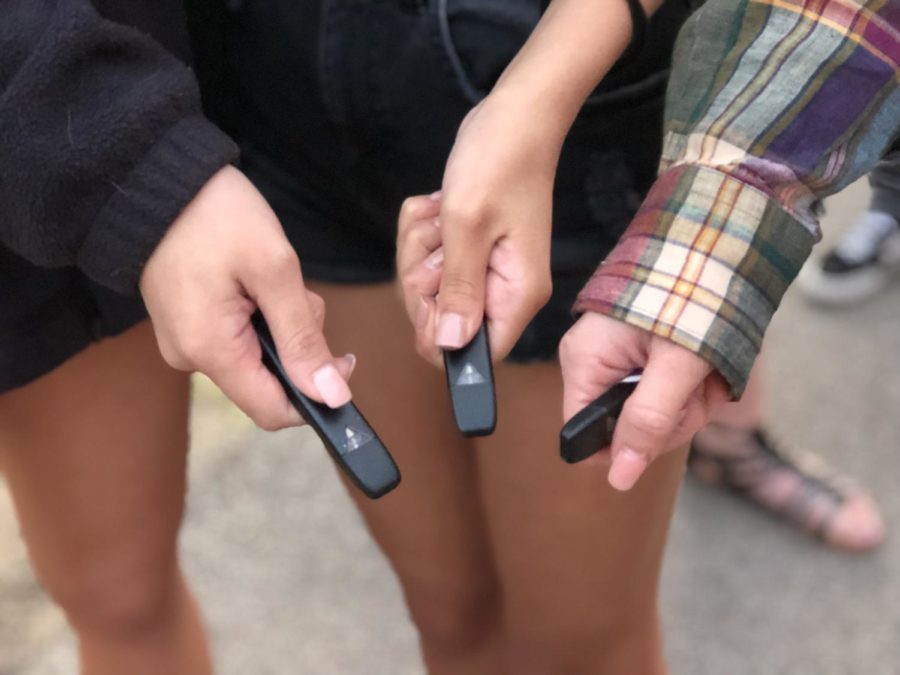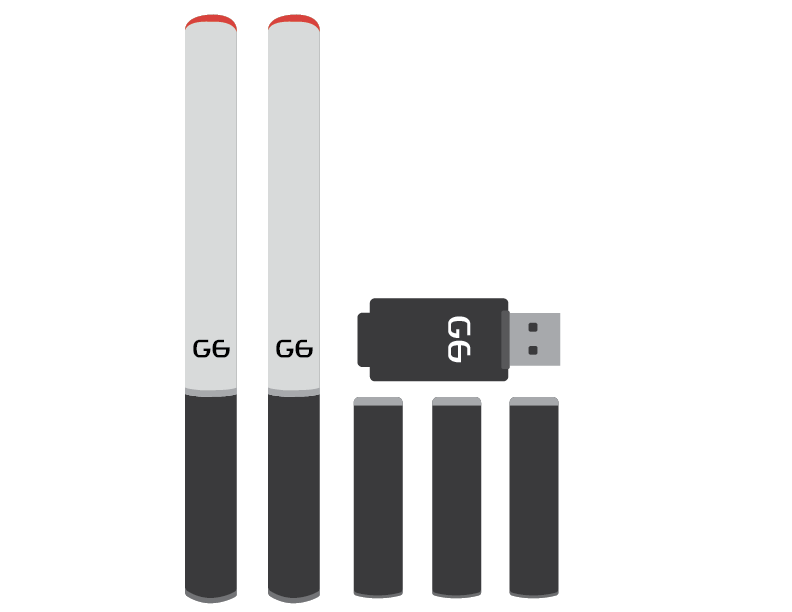Blurred circumstances: From campus to company, consequences for vaping cross loose lines
November 9, 2017
The thick, sweet fruity smell fills my head as I step into the bathroom. A girl swipes at the air and slyly pockets a silver device as the space in front of her becomes smudged and blurry.
The problem staring Coppell in the face: A look into roadblocks associated with reinforcement of rules
It is not altogether unusual for students to witness their peers using vape pens or e-cigarettes on the Coppell High School campus. Walking through the hallways, smelling the sickly sweet juices is a very real possibility. However this year, students who have witnessed others illegally using the pens or e-cigs have started to turn in students at fault.
The school is doing what it can to address the problem, but there is only so much they can do to actively combat the issue.
“We have to have reasonable suspicion that somebody is in possession of something like a vape pen or vape product then we have the authority to search,” Coppell High School principal Dr. Nicole Jund said. “We have to actively try to eliminate those things on campus, if we don’t actively try to eliminate that then we are allowing for it to happen.”
The problem extends beyond Coppell High School, with students getting busted for vaping on campus at the middle schools as well.
According to Coppell Middle School North student resource officer Rachel Freeman, there have been a few students caught with vapes on their persons while in the school.
“Vaping is a problem among middle school students in general,” Freeman said. “We did have some isolated incidents [where students were caught with vapes on campus last year.] But what is reported and what is actually going on is very different. We don’t get a lot of reports about it because it’s not something that kids are going to tell on each other [for].”
Freeman thinks students at the middle schools are reluctant to turn in other students for vaping because middle schoolers are still deciding what they do and do not stand for. The lack of maturity makes this age group more susceptible to peer pressure and less likely to stand up against someone. However, high schoolers are more grounded in what they stand for, or in this case, do not stand for, meaning high school students are more comfortable ousting someone for activities they see as wrong.
“At the middle school level kids are just trying to figure out who they are and what they are about, and I think by high school you’ve got it kind of figured out a little bit better,” Freeman said. “I think by high school you’re just a lot more comfortable and a lot more confident about who you are as a person and what you stand for. I think in middle school there’s still a lot of uncertainty, you know the ‘I know this is wrong but I don’t know what I should do about it.’”
While Coppell Middle School East has yet to catch students vaping on the East campus, Principal Laura Springer is not naive enough to doubt the probability of the existence of the problem.
“So far we’ve had a couple of our kids go to another middle school event and got caught vaping at another school,” Springer said. “We have not caught anyone, that doesn’t mean they’re not doing it – they’re real crafty – but so far we have not caught one person vaping. We have drug dogs come in regularly and we’ve not caught them with any paraphernalia. I’m not going to be naive and say our kids don’t, but they have not been caught at school doing it yet.”
Springer attributes the East environment of love and support to the impact she makes on the decisions her students come across.
“We really stress respect here,” Springer said. “I try to talk to them about that fact that I’m their school momma, and I would be really disappointed if I caught them doing something they shouldn’t do. We are going to try to keep you safe here and love you. I really believe you’ve gotta love kids hard to keep them from doing horrible things to themselves. I want to make sure that y’all all know that y’all are like my kids, I love you like your mom, I do not want any of my kids vaping.”
“You start that by teaching you all very early on to respect yourself, to respect your bodies, to respect each other. It’s one of the reasons I moved to the middle school. When I was at the high school it broke my heart how many kids were broken up there. I was trying to put them back together, but once they’re broken it’s hard to put them back together, so I thought I gotta catch them before they break and see if we can keep some of them from breaking at all.”
According to the 2017-2018 CHS Student Code of Conduct, it is against the rules to possess, use, give, sell or buy “electronic cigarettes and any component, part or accessory for an e-cigarette device.”
The problem does not subside outside school walls. According to SB No. 97, a document outlining the regulation of possession, selling and use of e-cigarettes, possession, purchase, consumption or receipt of cigarettes, e-cigarettes, or tobacco products by minors, is prohibited. In addition, there are consequences for minors who are caught possessing, purchasing, consuming or accepting these products, which include attending an e-cigarette and tobacco awareness program, or eight to 12 hours of community service.
According to the CHS Student Code of Conduct, “school administration will report crimes as required by law and will contact local law enforcement regarding suspected criminal activity committed while under the school’s jurisdiction.”
However, a minor vaping is only considered a class C misdemeanor, on par with theft under $100, public intoxication and minor in possession of alcohol or tobacco. Under SB 393, a bill defining the legal prosecution of minors accused of class c misdemeanors, officers cannot write class C tickets on campus to persons under the age of 18, so class C misdemeanors can only be treated as school administrative or disciplinary issues.
This leaves the school to manage vaping on campus internally, causing the severity of punishment of a minor vaping on campus to have potentially more lenient punishments that getting caught off-campus. Even if a tip is given through Coppell Crime Stoppers about a student vaping on campus the campus, student resource officers must hand the problem over to administration. If the tip is given to the school and not Coppell Crime Stoppers, the school cannot report the offense to the authorities.
The only case where a minor is prosecuted for illegally using a vape is when a tip is called in that is about a minor vaping outside of school jurisdiction, in which case the police will determine if a citation is necessary.
“End game for us is it needs to not come to school. We did up the consequences for [vaping on campus],” CHS Principal Dr. Nicole Jund said. “We know that it is a community expectation that I do everything I can to keep it out of school.”
This year, when a student is caught on campus with a vape once, the device is confiscated and only returned to the parents of the student. The student will also be given a minimum of two days of in-school suspension. Jund said that while she could not release exactly what would take place in the circumstance that a student brings a vape to school more than once, consequences do increase for multiple time offenders.
Another impact of SB 393 is that Coppell Crime Stoppers is not paying for tips about vaping as any tips will not result in an arrest.
Fortunately, despite not receiving a reward, students continue to turn in other students for vaping on campus.
“Other students are starting to report it more because they’ll go into the bathrooms or their classrooms and it’s distracting them,” CHS Student Resource Officer Chris Cobb said.
Even with the tips, it can be difficult to catch a student and correct the behavior.
“Some of the tips aren’t specific enough,” Cobb said. “It’s kind of hard for us or the [assistant principals] to actually go pull a student out to handle a tip, it’s gotta be a little more specific.”
The harsh reality: Ignored truths of using of vapes, with or without nicotine
Vapes consist of a battery, a heating coil, and an absorbent material (like cotton) that absorbs liquid called e-juice that contains flavors and sometimes nicotine. As the e-juice is heated up, the device creates an aerosol that is inhaled into the lungs and then exhaled out into the air.
It is important to understand that vapes create an aerosol and not vapor because aerosol, unlike vapor which is solely gas, contains solid particles within a gas. According to Stanford Medicine, rather than mixing with the air as gas does, aerosols leave particles, often containing chemicals, behind. Some of the chemicals that can be found in vapes are known to cause cancer, and while it is currently unknown if second hand smoke is a danger with vaping, third hand smoke is.
The aerosol leaves behind those particles, on surfaces and dust. These particles react with other chemicals near by and can create dangerous chemicals that can be introduced to others through ingestion, respiration or even skin exposure.
In some cases, vaping is considered a healthier alternative, able to help people more easily recover from a cigarette smoking addiction.
“A lot of younger kids who are over 18 they do it for the flavor,” managing partner of Jetstream Vape in Coppell Nathan McWhorter said. “A lot of times you get someone who’s 18 or 19 and they’ve never smoked but they want to get zero nicotine. But our primary draw is quitting smoking. We put them at the nicotine level they’re used to and we drop them down very slowly.”
However, teenagers who begin using the devices with nicotine risk becoming addicted to the drug and racking up a bill paying for juices because of it. Not only will they have to pay for their addiction, they will have to deal with it when they can not have nicotine, such as during the school day.
Addiction to nicotine is caused by changes in brain chemistry which causes users to crave more nicotine.
Along with addiction, nicotine can cause adverse effects on the brain. Nicotine causes a flood of chemicals to the brain that cause intense feelings of pleasure, but when it’s gone it leaves the user unable to feel normal emotions naturally.
The reality is, many students who continue to bring vapes or e-cigarettes to school despite the increased risk do so because they are addicted to nicotine.
Even using a vape with no nicotine can be harmful. Many of the flavors used in vapes are known to contain toxic chemicals. Dicetyl is found in many of the sweet flavors and is known to cause constrictive bronchiolitis obliterans (popcorn lung) which is scarring within the lungs. Teens vaping with nicotine can cause problems with brain development in the prefrontal cortex that can be long lasting and cause psychiatric disorders later in life.
“There’s this perception that it’s just a cloud of dust,” Jund said “It does have addictive properties. It’s something that is still relatively new, and we don’t know 100 percent what the longterm outcomes and implications vaping will have on our health.”
In addition to these risks, there are probably countless more. It took years to prove that cigarettes are dangerous, who is to say the same thing won’t happen with vapes?
Editor’s note: This story is a part of The Sidekick’s continuous coverage on vaping. Visit this article for further information.














